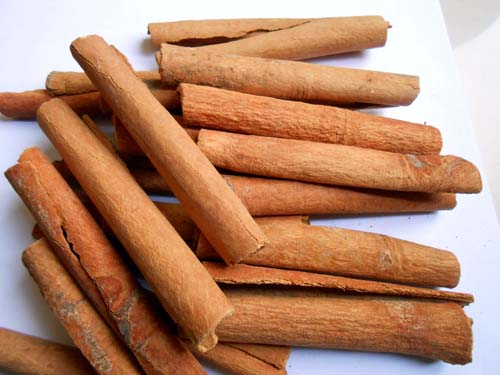The source is from the bark of Cinnamomum cassia Presl, family Lauraceae. The medicinal material is mainly produced in the areas of Guangdong, Guangxi, and Yunnan, etc.. Darked in autumn and then the bark is dried in the shade, cut into pieces or powdered and the crude form is used.
Medicinal Properties: Pungent and sweet in flavor, hot in nature and attributive to the spleen, kidney and heart meridians.
Actions: Supplement fire and strengthen yang, expel cold and alleviate pain, warm channels to promote the circulation of the blood.

Application
1. It is used for insufficiency syndromes of kidney-yang. For insufficiency of kidney-yang with impotence, chilliness, soreness and coldness of loins and knees, frequent micturition, seminal emission, and enuresis, etc., it is usually used in combination with Fuzi (Radix Aconiti Lateralis Praeparata ), Shudihuang ( Rhizoma Rehmanniae Praeparatae ) , and Shanzhuyu (Fructus Corni), etc., such as Shenqi Wan (Pill); for syndrome with deficiency and weakness of kidney-yang and up-floating of deficiency-yang, manifested as flushed face, dyspnea due to deficiency, the herbal medicine can be used in combination with Fuzi (Radix Aconiti Praeparata ) so as to direct fire to its source.
2. It can be used to treat all pains due to accumulation of cold and stagnation of qi or stasis of the blood. For deficiency and coldness of the spleen and stomach marked by cold pain in epigastric abdomen, it can be used alone or together with Ganjiang (Rhizoma Zingiberis) and Gaoliangjiang (Rhizoma Alpiniae Officinarum) ; for colic of cold type with abdominal pain, usually used in combination with Wuzhuyu (Fructus Evodiae), Xiaohuixiang (Fructus Foeniculi); for dysmenorrhea and amenorrhea, usually combined with Danggui (Radix Angelicae Sinensis ) and Chuanxiong ( Rhizoma Chuanxiong), etc..
3. For pudendal carbuncle and pyocutaneous disease of deficienct-cold type that has not been healed for a long time, it is combined with Lujiaojiao ( Colla Comus Cervi ) , Paojiang (Rhizoma Zingiberis Praeparata ), and Mahuang (Herba Ephedrae), etc., such as Yanghe Tang (Decoction); or combined with Huangqi (Radix Astragali), Danggui (Radix Angelicae Sinensis), etc., such as Tuoli Huangqi San (Powder).

Usage and Dosage:
2 - 5 g is used in decoction for oral use and decocted later or soaked in water for taking; 1 - 2 g of the powder is taken after it is mixed with water.
Notes:
Contraindicated for bleeding due to blood-heat and used with caution for hypermenorrhea and in pregnant women.
Explanation:
Rougui (Cortex Cinnamomi ) and Guizhi (Ramulus Cinnamomi ) are from same plants, the barks of which are used as medicine that is called Rougui ( Cortex Cinnamomi) ; the tender branches of which are used as medicine that is called Guizhi (Ramulus Cinnamomi ). The both medicines can expel cold and strengthen yang, Guizhi (Ramulus Cinnamomi) dominates going up to be a bit on the side of expelling cold to relieve exterior syndrome while Rougui ( Cortex Cinnamomi) dominates warming the interior to enter the lower energizer, being a bit on the side of warming kidney-yang.

![Diseases, Symptoms, tcm, [tcmwindow.com]](/uploadFile/adImg/2015/4/24/6de633b8-0a7a-4546-868a-02389edf5c65.png)





